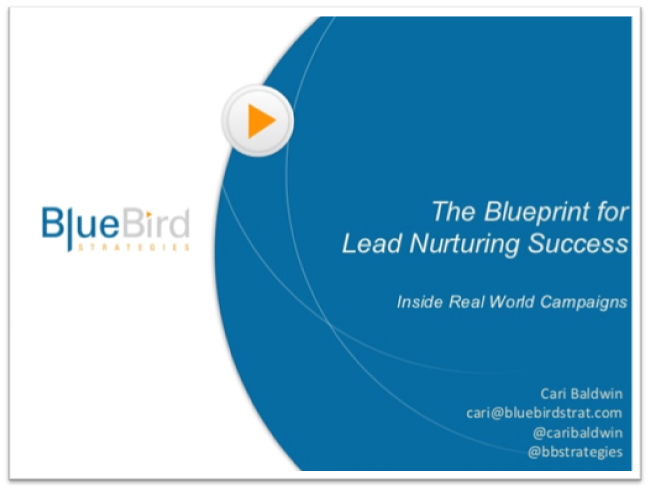Most B2B marketers understand the importance of lead nurturing, and they’re eager to get started. The key to a successful nurturing campaign, however, isn’t just about execution – it’s also about preparation.
This was one of the key issues discussed during a recent webinar, Lead Nurturing: The Blueprint For Building Successful Campaigns, presented by Demand Gen Report and sponsored by lead generation consultancy BlueBird Strategies. While the webinar offered a number of tips on designing and executing lead nurturing campaigns, it also stressed the role that content, lead management and other foundational activities play in a successful nurturing strategy.
“When we talk about building a foundation for our nurture programs, the two things we start with are content and process,” said speaker Cari Baldwin, Founder of BlueBird Strategies. “You really have to have your content and processes nailed down to build out a well thought-out nurturing strategy.”
Content Lays The Foundation For Successful Nurturing
Content is clearly a pressing concern for many B2B marketers; according to a snapshot poll taken during the webinar, 47% responded that a lack of content for every stage of the buying process was their single biggest lead nurturing challenge. Yet while many marketers recognize the problem, Baldwin said that too many marketers try to “solve” the problem by forcing their existing content to do things it wasn’t designed to do.
“The worst position you want to be in is trying to map a nurture to the content that you have. That’s really putting the cart before the horse,” said Baldwin.
“You’ve got to make sure that you have a full variety of content in place that addresses all of the different [buying stages] and then you can build your nurture strategy from there.”
Baldwin offered examples of how a content audit can map appropriate categories of content to different points in the lead generation funnel. For example, top-of-funnel content might include white papers, webinars, E-books, how-to guides, executive briefs and infographics; middle-of-funnel content could include case studies, trial and demo offers, decision-making tools and content targeting specific buyer interests.
In order to tie together a series of relevant content offers, Baldwin also emphasized the need to understand a prospect’s online behavior and intentions. “If you want to know when they’re ready to move on to more specific content, you have to watch their behavior and have a good understanding of their qualification issues – and that leads back to having a good scoring model,” she explained.
Working Together: The Lead Management Workshop
Lead scoring also leads to the second element of a foundational approach to lead nurturing – the necessity of building supporting organizational processes.
According to Baldwin, the BlueBird Strategies team usually addresses process issues with a lead management workshop. The idea, she stated, is to get key stakeholders into the same room in order to agree upon key concepts, create shared definitions and metrics, document workflows and then get buy-in for the resulting lead nurturing strategy.
“It’s really about getting buy-in from the sales and marketing leadership,” Baldwin said. “It can document and define the processes you already have, but ideally it’s also about the process that you want to move towards.”
In more specific terms, Baldwin suggested asking the following questions as part of a lead management workshop:
- How do the sales and marketing organizations define a lead?
- How do both organizations create a shared definition of marketing qualified leads and sales qualified leads?
- How and why will a nurturing campaign specify certain actions at specific touchpoints?
- When will a nurturing campaign begin and how long will it run?
- When will a nurturing campaign remarket leads that have been rejected or recycled by sales?
- How will sales and marketing handle lost opportunities?
Answering these questions, Baldwin said, will give sales and marketing a shared stake in lead nurturing outcomes, provide fodder for an effective lead scoring strategy, and ensure accountability for the results.
In addition to providing vital background for nurturing campaigns, however, Baldwin pointed out that the process of answering these questions can create more general benefits.
“It’s a really good opportunity for us as marketers to show our sales partners that we’re in it for the long haul,” she said. “We’re not just going to throw those leads over the wall anymore. We’re going to work with sales to develop a process and a series of programs to give them the kinds of leads that are ready for an interactive and educated sales conversation.”
Measuring Success From ‘Waking The Dead’
Baldwin also offered a powerful example for marketers still on the fence about lead nurturing, in the form of a case study that demonstrates the benefits of a well-executed nurturing campaign.
The campaign in question, involving a government contracting service provider, is what’s referred to as a “wake the dead” nurture. The goal, according to Baldwin, was to revisit stalled or dormant opportunities in search of quick sales wins that might otherwise get overlooked. It’s also the kind of campaign that illustrates the marriage of quality content with a clear-cut process that allows marketing and sales to work together and communicate effectively.
The results, Baldwin noted, speak for themselves. With a relatively minimal investment in new content and an appropriate nurturing workflow, the campaign created or influenced 24 opportunities. Better yet, the campaign generated an immediate $200,000 win for the organization’s sales team, as well as more than $5 million added to the pipeline.
“The results were really rewarding based on the investment that we made in the campaign,” Baldwin said. “If you think about it, had we not done this, those opportunities would have gone to a competitor – or died a slow, painful death in the ‘disqualified leads’ bucket.”







